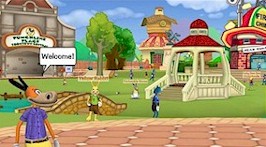 |
|
Online Game Review: Toontown |
 |
By Disney
Windows 98/Me/2000/XP
Released: 2003
Reviewed: February 2004
Our Recommended Age: 7-14
Our Rating: A
|
|
|

|
|
|
| Get Disney's Toontown Online |
|
Screenshots: |
|

|
|

|
|

|
|
|
|

Top
Pick. This 3D
online game impressed us, and continues to do so.
Multiplayer would be an understatement--in fact, officially,
the adjective "massively" goes along with "multiplayer"
to describe the experience of Disney's Toontown.
Any given moment during the day, there are thousands of
children playing the game.
Parents
need to sign their children up for Toontown, which costs
$9.95 per month, although a free 3-day demo is available. A
player becomes a Toon--a cat, dog, mouse, rabbit, duck, or
horse--that can be customized by mixing and matching
body parts, colors, and clothes. Kids choose a gender for
their Toon, as well as a name. Names can be generated, with such funky
selections as Baron von Wrinklezilla or Rosie Kookyhopper.
Alternatively, names can be created,
although they must be run past the Toon Council for
approval.
The
underlying story in Toontown is this: evil business robots,
called Cogs, have been unwittingly released in Toontown.
They are trying to turn the very colorful and happy town
into a black-and-white corporate world of drab business buildings.
But, the Cogs can be defeated by playing with their
weakness--they don't have a sense of humor! Toons defeat
Cogs by using a variety of gags, such as cream pies and
squirt flowers. There are 4 types of Cogs (Lawbots, Cashbots,
Bossbots, and Sellbots) and there are 8 different varieties
of Cogs for each type.
Using
"gags" as weapons, Disney has done a fantastic job of creating a
game that is non-violent.
Children
begin the game by playing a tutorial. They learn that they
must complete jobs, called Toontasks, in order to win
prizes. Children earn jellybeans (Toontown's currency) to
purchase new gags, as well as new abilities, laffpoints, and
more. Over time, they develop their skills in throwing,
squirting, trapping, and so forth, and the game grows along
with their budding skills. Mini-games are abundant
and are completed using various combinations of luck and skill.
Jellybeans are earned for success in the games.
Each
player is given his/her own house where collectibles are
stored. Toontown consists of a number of different
neighborhoods, each of which features a Cog-free playground.
Kids can journey off to meet the Cogs by entering one of the
streets that branch off from the playground.
There is
a strong social component to the game that is fascinating.
As children guide their Toon through Toontown, they
encounter other players. They can stop to "talk"
to another Toon using dozens of pre-made chat phrases,
including such things as "I like your shirt" and
"Can you help me?" Kids can also chat with their
real-life friends (subscribers only) but they will need to exchange
a password that allows them to chat in the game using the
keyboard. A filtering engine is in place for these private
chats and other Toons are unable to view the dialogue. Players are allowed
to add Toons to their friend list and can maintain up
to 50 friends. Players can see which of their friends are
online, and can teleport directly to them if desired.

Toons can
access a variety of items through their "Shticker
Book"--a map of Toontown, their Cog Gallery, gags,
tasks, and more. Children use both their mouse and
keyboard.
For each account created, there are 6
possible Toons to create. This means that siblings (and
parents!) can enjoy their own separate adventures in
Toontown with only one account.
There are
several features of Toontown that parents will find both
impressive and reassuring. The online game is designed to be
safe and non-violent--Toons cooperate with other Toons and
cannot intimidate or hassle each other; Toons never die
(they can become "sad", but have the chance to
heal and boost up their laffpoints); and chatting with other
people is restricted and controlled.
The game
is creatively designed to be played by a wide range of skill
levels and ages. For one, the game is playable for younger
children right from the start, and its challenges grow
gradually. At the same time, older children will find plenty
of challenges as they build their skills. As well, the
appeal of the game is broad. It is humorous and intriguing
for children as young as 6 or 7, and yet still manages to
entertain older children and even some adults.
Things
parent should consider: Children need to be able to read
(text bubbles) in order to move through Toontown. At times,
the game can be rather slow-moving. Although Disney
purposely set up the game with short play sessions, kid
testers quickly became addicted to the game, demanding more
and more time on the computer.
We found
the game's cost ($9.95 per month) well worth it. Two or
three months of Toontown, for example, will cost the same as
many software games, and Toontown has excellent replay
value.
 |
|
Pros: |
 |
- Broad appeal
- Challenges grow with the
skills of players, keeping kids ages 7 and up at a
comfortable level
- Safe, non-violent,
humorous, and happy experience
- Impressive features
- Cooperation and
friendliness are promoted
|
|
 |
|
Cons: |
 |
- Sometimes slow-moving
- Addictive for some children; could
have been more educational
|
|

|
|
|
|
To buy: Disney's Toontown Online (includes 2 months with an option, of course, to
renew).
(includes 2 months with an option, of course, to
renew). |
|
|
| Reviewed February 2004 |
|
|
|